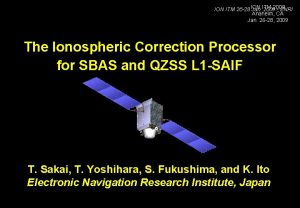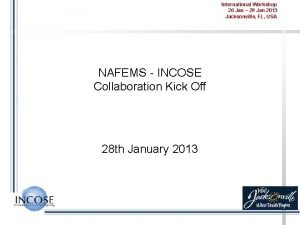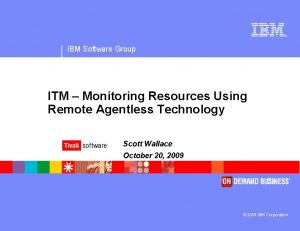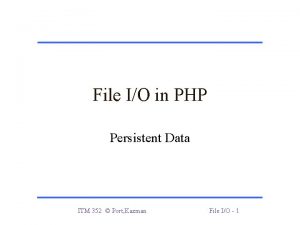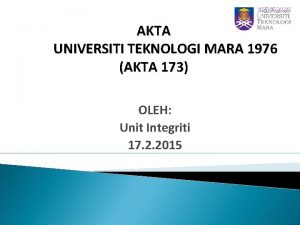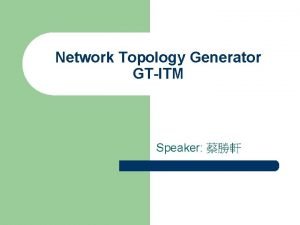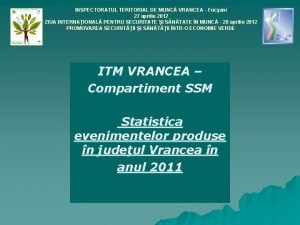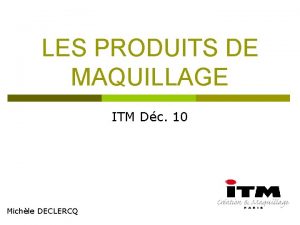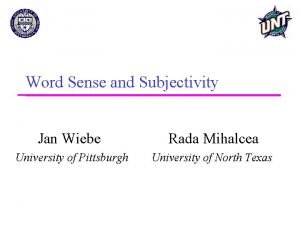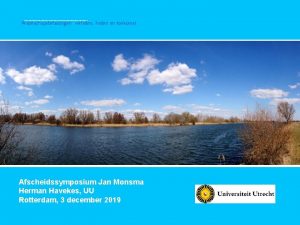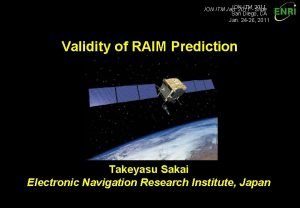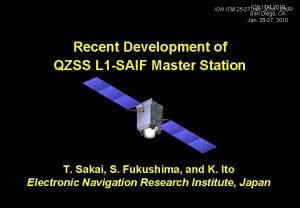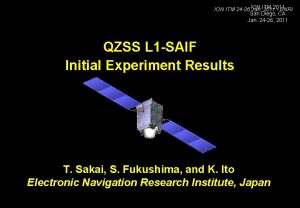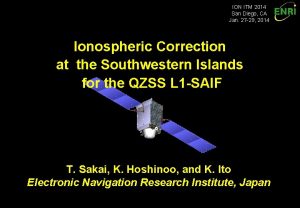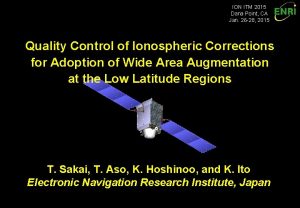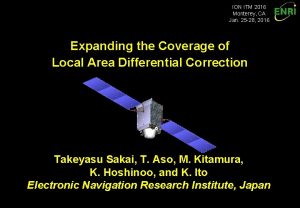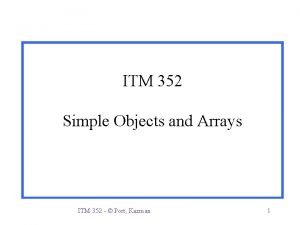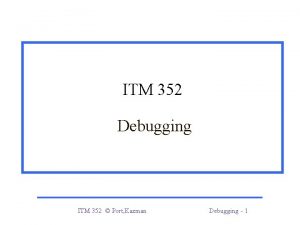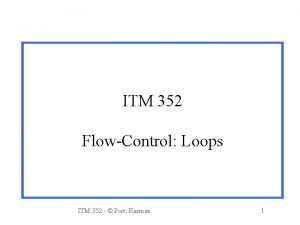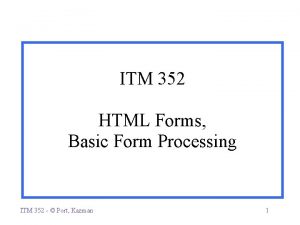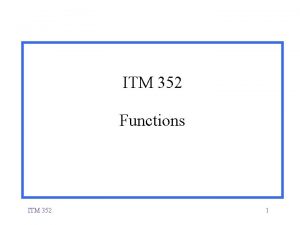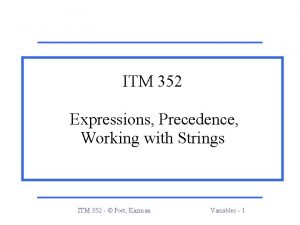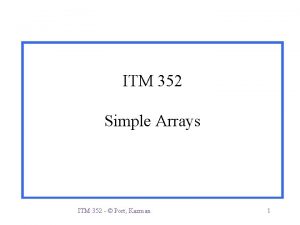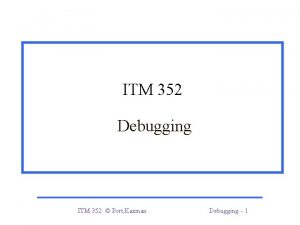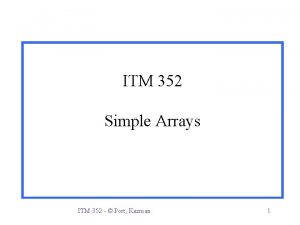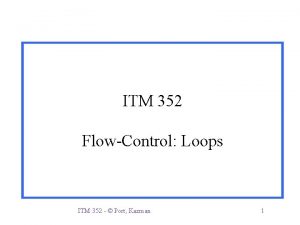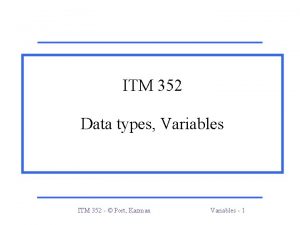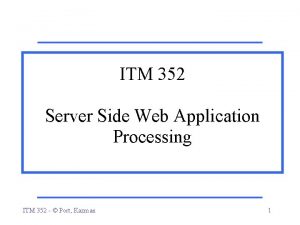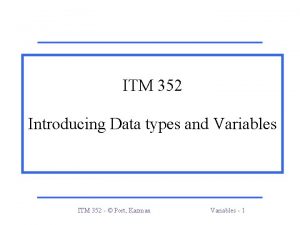ION ITM 2013 ION ITM Jan 2013 Slide
























- Slides: 24

ION ITM- 2013 ION ITM Jan. 2013 Slide San Diego, CA Jan. 28 -30, 2013 QZSS L 1 -SAIF Supporting GPS/GLONASS Multi-Constellation Augmentation T. Sakai, H. Yamada, K. Hoshinoo, and K. Ito Electronic Navigation Research Institute, Japan

ION ITM Jan. 2013 - Slide 1 Introduction • QZSS (Quasi-Zenith Satellite System) program: – Regional navigation service broadcast from high-elevation angle by a combination of three satellites on the inclined geosynchronous (quasi-zenith) orbit; – Broadcast GPS-like supplemental signals on three frequencies and two augmentation signals, L 1 -SAIF and LEX; – The first QZS satellite was successfully launched on Sept. 11, 2010. • L 1 -SAIF (Submeter-class Augmentation with Integrity Function) signal offers: – – – Submeter accuracy wide-area differential correction service; Integrity function for safety of mobile users; and Ranging function for improving position availability; all on L 1 single frequency. • ENRI has been developing L 1 -SAIF signal and experimental facility: – Possible to extend to augment GLONASS satellites; – Upgraded to support multi-constellation environment including GPS, GLONASS, and QZSS satellites; – Conducted experiment with broadcast of multi-constellation augmentation.

ION ITM Jan. 2013 - Slide 2 QZSS Concept GPS/GEO • • • Footprint of QZSS orbit; Centered at 135 E; Eccentricity 0. 075, Inclination 43 deg. QZS • Broadcast signal from high elevation angle; • Applicable to navigation services for mountain area and urban canyon; • Augmentation signal from the zenith could help users to acquire other GPS satellites at any time.

ION ITM Jan. 2013 - Slide 3 L 1 -SAIF Signal QZS satellites Ranging Function GPS Constellation Error Correction Integrity Function • Three functions by a single signal: ranging, error correction (Target accuracy: 1 m), and integrity; • User receivers can receive both GPS and L 1 -SAIF signals with a single antenna and RF front-end; • Message-oriented information transmission: flexible contents. SAIF: Submeter-class Augmentation with Integrity Function Ranging Signal User GPS Receivers

ION ITM Jan. 2013 - Slide 4 L 1 -SAIF Signal • QZSS broadcasts wide-area augmentation signal: – Called L 1 -SAIF (Submeter-class Augmentation with Integrity Function); – Designed and developed by ENRI. • L 1 -SAIF signal offers: – Wide-area differential correction service for improving position accuracy; Target accuracy: 1 meter for horizontal; – Integrity function for safety of mobile users; and – Ranging function for improving position availability. • Augmentation to GPS L 1 C/A based on SBAS techniques: – Broadcast on L 1 freq. with RHCP; Common antenna and RF front-end; w Modulated by BPSK with C/A code (PRN 183); w 250 bps data rate with 1/2 FEC; Message structure is identical with SBAS; w Differences: Large Doppler and additional messages. – Specification of L 1 -SAIF: See IS-QZSS document (Available at JAXA HP).

ION ITM Jan. 2013 - Slide 5 L 1 -SAIF Corrections • Example of user position error at Site 940058 (Takayama: near center of monitor station network); • Realtime operation with MSAS-like 6 monitor stations; • Period: 19 -23 Jan. 2008 (5 days); • L 1 -SAIF provides corrections only; No L 1 -SAIF ranging. Horizontal Error Vertical Error Standalone RMS GPS Max 1. 45 m 2. 92 m 6. 02 m 8. 45 m RMS 0. 29 m 0. 39 m Max 1. 56 m 2. 57 m System Standalone GPS Augmented by L 1 -SAIF Augmentation to GPS Only Note: Results shown here were obtained with surveygrade antenna and receiver in open sky condition.

ION ITM Jan. 2013 - Slide 6 GLONASS Support: Motivation QZSS L 1 -SAIF Augmentation GPS constellation Additional Constellation = GLONASS • Increase of augmented satellites improves availability of position solution; • Chance of robust position information at mountainous areas and urban canyons. • The current SBAS specification already has definition of GLONASS; Easy to support by L 1 -SAIF.

ION ITM Jan. 2013 - Slide 7 Time and Coordinate Systems • GLONASS Time: – GLONASS is operating based on its own time system: GLONASS Time; – The difference between GPS Time and GLONASS Time must be taken into account for combined use of GPS and GLONASS; – The difference is not fixed and slowly changing: about 400 ns in July 2012; – SBAS broadcasts the difference by Message Type 12; w GLONASS-M satellites are transmitting the difference as parameter t. GPS in almanac (non-immediate) data: t. GPS = t. GPS − t. GLONASS. • PZ-90 Coordinate System: – GLONASS ephemeris is derived based on Russian coordinate system PZ-90; – The relationship between WGS-84 and the current version of PZ-90 (PZ-90. 02) is defined in the SBAS standard as:

ION ITM Jan. 2013 - Slide 8 PRN Masks • PRN Mask: – SBAS/L 1 -SAIF transmits PRN mask information indicating satellites which are currently augmented; – PRN number has range of 1 to 210; – Up to 51 satellites out of 210 can be augmented simultaneously by the single SBAS/L 1 -SAIF signal; But, 32 GPS + 24 GLONASS = 56 !!! PRN definition for SBAS PRN Contents 1 to 37 GPS 38 to 61 GLONASS slot number plus 37 62 to 119 Spare 120 to 138 SBAS 139 to 210 Spare • Solution: Dynamic PRN Mask – Actually, PRN mask can change; Controlled by IODP (Issue of Data, PRN Mask); – Change PRN mask dynamically to reflect the actual visibility of satellites from the intended service area.

ION ITM Jan. 2013 - Slide 9 IOD (Issue of Data) • IOD indicator along with corrections: – LTC (Long-Term Correction) in SBAS Message Type 24/25 contains orbit and clock corrections; – Such corrections depend upon ephemeris data used for position computation; – IOD indicates which ephemeris data should be used in receivers. • IOD for GPS satellites: – For GPS, IOD is just identical with IODE of ephemeris data. Previous Ephemeris IODE=a Next Ephemeris IODE=b Time LTC IOD=a LTC IOD=b

ION ITM Jan. 2013 - Slide 10 IOD for GLONASS • IOD for GLONASS satellites: – GLONASS ephemeris has no indicator like IODE of GPS ephemeris; – IOD for GLONASS satellites consists of Validity interval (V) and Latency time (L) to identify ephemeris data to be used: w 5 MSB of IOD is validity interval, V; w 3 LSB of IOD is latency time, L. – User receivers use ephemeris data transmitted at a time within the validity interval specified by L and V. Previous Ephemeris Next Ephemeris Time LTC IOD=V 1|L 1 Ephemeris Validity Interval V 1 LTC IOD=V 2|L 2 Ephemeris Validity Interval V 2 L 2

ION ITM Jan. 2013 - Slide 11 Satellite Position • GLONASS ephemeris data: – GLONASS transmits ephemeris information as position, velocity, and acceleration in ECEF; w Navigation-grade ephemeris is provided in 208 bits for a single GLONASS SV; w Broadcast information is valid for 15 minutes or more. – Numerical integration is necessary to compute position of GLONASS satellites; – Note: centripental acceleration is removed from transmitted information. w These terms can be computed for the specific position and velocity of SV; w GLONASS ICD A. 3. 1. 2 gives the equations below (with some corrections). Perturbation terms in ephemeris

ION ITM Jan. 2013 - Slide 12 Upgrade of L 1 SMS • L 1 -SAIF Master Station (L 1 SMS): – Generates the L 1 -SAIF message stream and transmits it to JAXA MCS. • Upgrade for supporting GLONASS and QZSS: Input module: Supports BINEX observables and navigation message records; Implemented GLONASS extension based on SBAS standards; User-domain receiver software (MCRX) is also upgraded to be GLONASS-capable; QZSS is also supported as it is taken into account like GPS. QZS GPS L 1 SA L 2 SA GEONET GSI L 1 C/ A, Measured Data L 2 P al n g Si IF Closed A -S Loop L 1 SMS ENRI L 1 -SAIF Message nd ba K- GLONASS L 1 C/A , L 2 P – – QZSS MCS JAXA

ION ITM Jan. 2013 - Slide 13 Dynamic PRN Mask • Dynamic PRN mask: – Changes PRN mask dynamically to reflect the actual visibility of satellites; – Set PRN masks ON for satellites whose pseudorange observations are available; Not based on prediction by almanac information not provided by RINEX; – Semi-dynamic PRN mask: Fix masks ON for GPS and QZSS, and change dynamically only for GLONASS to reduce receiver complexity. • Transition of PRN mask: – Periodical update of PRN mask: updates every 30 minutes; – Transition time 180 s is given to users to securely catch the new PRN mask. Transition time 180 s tcutover PRN Mask (IODP=i) FC FC LTC FC Cutover PRN Mask (IODP=i+1) FC LTC Corrections before cutover FC FC LTC FC Corrections after cutover FC

ION ITM Jan. 2013 - Slide 14 GLONASS Time Offset • Realtime computation: – Computes as the difference between receiver clocks for a group of GPS satellites (and QZSS) and the other group of GLONASS satellites; – Enough accuracy with a filter of long time constant; – Need no almanac information broadcast by GLONASS satellites; – Transmitted to users via Message Type 12 of SBAS. True Time GLONASS System Time t t. GLONASS GPS System Time Receiver clock for GPS satellites t. R ^ B GLONASS Dt. GPS Time offset broadcast to users t. GPS Receiver Time -da. GLONASS ^ B GPS Receiver clock for GPS satellites

ION ITM Jan. 2013 - Slide 15 Experiment: Monitor Stations • Recently Japanese GEONET began to provide GLONASS and QZSS observables in addition to GPS; • Currently more than 150 stations are GLONASS/QZSS-capable; • Data format: BINEX • For our experiment: w 6 sites for reference stations; Reference Station (a) to (f) w 11 sites for evaluation. User Station (1) to (11) • Period: 2013/1/6 01: 00 to 2013/1/9 23: 00 (94 hours).

ION ITM Jan. 2013 - Slide 16 PRN Mask Transition QZSS GLONASS GPS • Reflecting our implementation, PRN mask is updated periodically at every 30 minutes; • Semi-dynamic PRN mask: GPS and QZSS satellites are always ON in the masks; • PRN masks for GLONASS satellites are set ON if the satellite are visible and augmented; • Stair-like shape: because the slot number of GLONASS satellites are assigned increasingly along with the orbit. • IODP (issue of Data, PRN Mask) indicates change of PRN mask.

ION ITM Jan. 2013 - Slide 17 Elevation Angle GPS GLONASS QZSS 5 deg PRN Mask Transition @ User (7) • Rising satellites appear at 5 -12 deg above the horizon; Latency due to periodical update of PRN mask; • However, GPS satellites also have similar latency; Not a major problem because low elevation satellites contribute a little to improve position accuracy.

ION ITM Jan. 2013 - Slide 18 # of Satellites vs. Mask Angle 16 SVs 9. 8 SVs 7. 3 SVs @ User (7) • Introducing GLONASS satellites increases the number of satellites in roughly 75%; • QZSS increases a satellite almost all day by only a satellite on the orbit, QZS-1 " Michibiki" • Multi-constellation with QZSS offers 16 satellites at 5 deg and 7. 3 satellites even at 40 deg.

ION ITM Jan. 2013 - Slide 19 User Position Error: Mask 5 deg • GPS+GLO+QZS: 0. 310 m RMS of horizontal error at user location (7); • Looks some limited improvement by using multi-constellation.

ION ITM Jan. 2013 - Slide 20 User Position Error: Mask 30 deg • GPS+GLO+QZS: 0. 335 m RMS of horizontal error at user location (7); • Multi-constellation offers a good availability even for 30 deg mask.

ION ITM Jan. 2013 - Slide 21 Error vs. User Location: 5 deg 0. 421 m 0. 283 m North South • Expect horizontal accuracy of 0. 3 to 0. 5 m with L 1 -SAIF augmentation, regardless GLONASS is used or not; • There is a little dependency upon the latitude of user location possibly due to an effect of ionosphere activities.

ION ITM Jan. 2013 - Slide 22 Error vs. User Location: 30 deg 0. 425 m North South • The horizontal accuracy is still within a range between 0. 3 and 0. 5 m for the multi-constellation configuration; • The accuracy degrades to 1 or 2. 5 m for GPS-only single-constellation configuration.

ION ITM Jan. 2013 - Slide 23 Conclusion • ENRI has been developing L 1 -SAIF signal: – Signal design: GPS/SBAS-like L 1 C/A code (PRN 183); – Planned as an augmentation to mobile users. • GPS/GLONASS/QZSS multi-constellation support: – L 1 -SAIF Master Station was upgraded to support GLONASS and QZSS in addition to GPS based on the existing SBAS specifications; – Conducted an experiment with broadcast of L 1 -SAIF signal containing augmentation information of GPS, GLONASS, and QZSS; – Using multi-constellation it can be expected to maintain a good position accuracy even in higher mask angle conditions representing limited visibility conditions. • Further Investigations will include: – – Dynamic PRN mask driven by almanac information; Use of GLONASS observables in generation of ionospheric corrections; Considerations of different types of receiver for reference/user stations; and Extension to Galileo.
 Ion itm
Ion itm Heel and toe polka dance
Heel and toe polka dance 29 jan 2013
29 jan 2013 Itm monitoring
Itm monitoring /index2.php?include= si|e: itm
/index2.php?include= si|e: itm Itm giurgiu
Itm giurgiu Akta 173
Akta 173 Network topology generator
Network topology generator Itm vrancea
Itm vrancea Itm maquillage
Itm maquillage Ion dipolo
Ion dipolo Ion dipolo
Ion dipolo Ejemplo de fuerza ion ion
Ejemplo de fuerza ion ion Phase diagram of carbon dioxide
Phase diagram of carbon dioxide Slide and divide steps
Slide and divide steps Jan wiebe
Jan wiebe Henryk dąbrowski pan tadeusz
Henryk dąbrowski pan tadeusz Nuborgh lf
Nuborgh lf Jan monsma
Jan monsma National ffa alumni association was formed
National ffa alumni association was formed Jan neruda prezentace
Jan neruda prezentace Zejtaria kuptimi
Zejtaria kuptimi Bilal chababi
Bilal chababi Jan clevers
Jan clevers Jan ketelhut
Jan ketelhut
